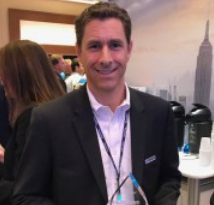Yardi’s Rob Teel, senior vice president of global solutions, and Todd Huebsch, vice president of commercial sales, discussed key trends in the commercial real estate industry in interviews at the recent Realcomm and IBCon conferences. Excerpts follow. Q: What are some key shifts that you’re seeing in commercial property management? Huebsch: From an enterprise platform standpoint, software products historically have been developed for people in back office operations such as accounting and property management. Now we see the emphasis rapidly changing to the front office—people in the field who are managing leases, construction projects and facilities. Enabling that move is a series of mobile apps and role-based tools that simplify tasks and help front office people do their jobs faster, easier and more efficiently while seamlessly connecting to the back office. These new capabilities speak to reducing risk and increasing asset value Q: What is Yardi’s primary focus area at present? Teel: There are three. One is Yardi Elevate, which, in contrast to the traditional chief financial officer focus of property management software, is tailored to a chief operating officer whose direct reports might include the leaders of leasing, asset management, construction and facilities management. Another key focus is energy management, which addresses the needs of COOs and chief engineers who are looking to reduce consumption and expenditures and boost sustainability. Yardi has made five acquisitions in three years in this area and it’s one of our leading long-term strategic visions. And coworking has gone through a revolution in the last two years. Today about 1% of commercial offices in the U.S. are tagged as coworking space but we think it might go to 5-10% in the U.S. and globally within a few years. We made two acquisitions that brought us the Yardi KUBE...
Investment Insight
From Rob Teel of Yardi
Investment capital isn’t in short supply—plenty is available from China, Europe, the U.S. and other sources. So why are real estate investors working harder, yet finding fewer high-return opportunities? One dampening factor is increased investor choosiness arising from due diligence activities that increased starting in 2009, when a low market virtually guaranteed returns and asset prices would rise. Plus, the regulatory climate has thickened. But the main problem today is that the marketplace, especially the U.S. with its abundance of capital, is chasing relatively few investment opportunities. Can fund managers under pressure to place money they’ve raised find, evaluate and capitalize on good deals? Yes, says Rob Teel, Yardi’s senior vice president of global solutions—if they have the means and ability to unearth opportunities they ordinarily wouldn’t consider, or even know about. We asked Teel for insight into how technology can be an ally in the effort to identify investment opportunities and manage assets through their life cycle. Q: What’s a key trend among the real estate property owners, managers and investors you encounter? Teel: A lot of people are seeing the advantage of automating investment accounting, performance measurement and investor reporting with an integrated investment and asset management system. They realize that having all decision-making tools within a single system exceeds what’s possible with spreadsheets and separate databases. Managers dealing with hundreds of combined funds, entities, properties and investors are happy to be free of manually uploading data, relying on cumbersome spreadsheets and mining data from separate systems. Q: What matters the most to investment managers as they evaluate potential acquisitions? Teel: Getting a complete picture that helps them decide to acquire an asset and the best option and optimal time for renovating or selling it. This underscores the importance of automating the...
Trends in Investment Management
Rob Teel Talks Commercial Real Estate
We talked to Rob Teel, Vice President, Yardi Global Solutions, about his thoughts on current trends in investment management, specifically commercial real estate portfolios. What’s hot? As a result of the global financial crisis, investors and portfolio managers are taking a heightened interest in three things: Cycle time, transparency, and risk analysis, before and after committing large amounts of capital to investment managers. Let’s break it down. Cycle time – The time between the end of the quarter and the production of investors’ returns and reports is crunch time. Shortening that cycle from weeks to days is a crucial component of keeping investors happy. Banks and investors are now asking for more frequent valuations of real property, which can be costly and time-consuming. Investors are also looking for forecasts, so they can anticipate the value of their investment in the years ahead. Yardi VMF creates full portfolio valuations, in an automated, accurate and repeatable way, quarter after quarter, or any frequency desired. Transparency – Investors and investment boards now want a heightened level of detail about how their commercial investment properties are doing, down to the level of tenant health. They aren’t satisfied with the pretty pictures of the assets traditionally included in quarterly reports, and want to drill down to find outstanding receivables and other property-specific information. Yardi Investor Portal provides a technology tool for frequently-published, data rich reports. Risk analysis – Successful investment management means monitoring a portfolio closely for potential trouble spots. Portfolio managers can choose the attributes they’ll monitor to keep close tabs on portfolio assets. Producing the best possible business intelligence platform for risk management is one of the goals of Yardi Orion, which uses Microsoft Sharepoint built on an OLAP data cube to give instant access to investment data. Wait, I can’t use Excel to manage my clients’ portfolios? In a word, no. Investors and institutional investment management boards – which oversee multi-million dollar funds on behalf of private individuals and trusts, retirement systems, and other investment entities, are asking for more intelligent business software solutions to ensure that their investments are monitored wisely. Investment managers need to account for accounting controls, risk controls, operational controls with a smart technology choice. You will not get institutional funding if you are running on an Excel spreadsheet. What’s next? The investment management industry should be focused on automating all aspects of the real estate life cycle, from end to end. That should include property operations, acquisitions, dispositions, monitoring, and risk analysis. All of the processes that are required can be automated, from the time you acquire that asset and attract new investors that help you acquire it, to the time you’re monitoring it, looking for outliers and patching up the health of your portfolio, to the time you need to dispose of it, get the right value for it and close it out....



